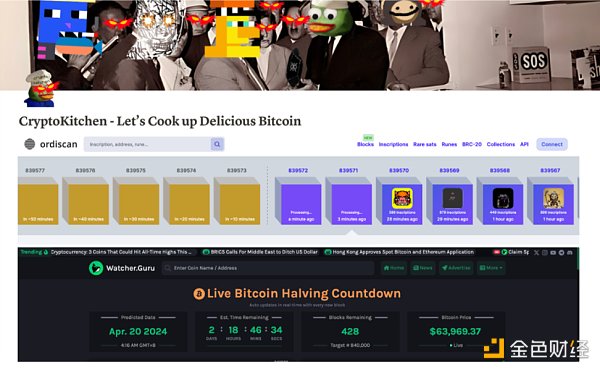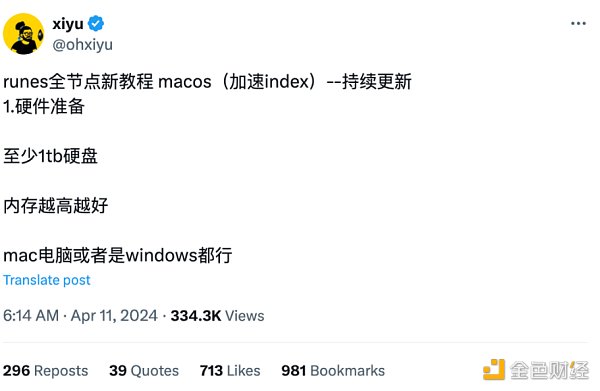Original source: Metaverse Special Forces
Three days later, at around 4 am Beijing time on April 20, 2024, Bitcoin will be halved for the fourth time in history.

This Bitcoin halving attracted the most attention and participation, which was the launch of the Runes protocol mainnet and the launch of the first rune token. As a Bitcoin builder, investor, enthusiast, or Fomo, do you deploy a full node yourself or rely on a platform to play?
As the fourth Bitcoin halving approaches, the industry's attention begins to focus on the "Runes Protocol" that was launched simultaneously. This homogeneous token protocol developed by Casey Rodarmor, the founder of Ordinals Protocol, aims to provide a more space-saving and responsible token issuance method than BRC-20.
In the recent Twitter timeline, you may have seen many KOLs publish a hand-in-hand guide to "layout full nodes" to welcome the arrival of the Runes Protocol.

So why do we need to lay out nodes? This is to talk about the creation and issuance mechanism of Rune tokens.
Etching is the first step in creating a Rune Token, a process that involves setting the basic characteristics and governance rules of the Rune Token, such as divisibility and minting conditions.
During the etching process, the project party can choose whether to "premine", that is, to pre-allocate a portion of the tokens to the founders or initiators of the project before the Rune Token is publicly circulated. This is mainly done to provide project start-up funds, reward developers, or reserve tokens for community activities and other specific distributions.
After etching is completed, it enters the "Minting" phase, which is the process of generating new tokens. Depending on the conditions set in the etching phase, minting can be open or closed:
Open Minting: Anyone who meets the preset conditions can create new tokens, which ensures that community members can actively participate in the development of the Rune ecosystem.
Sponsored Business Content
Closed Minting: New tokens can only be minted after certain preset conditions are met (such as reaching a certain amount or a certain time has passed). Once these conditions are no longer met, the minting process will stop, thereby limiting the total supply of tokens.
In order to avoid the first rune being snatched away or pre-mined by VC or project parties, Casey decided to hard-code the first 10 runes (Rune 0 - Rune 9) into the rune protocol and only support public minting so that everyone can participate publicly.

Among them, the rune number 0 named UNCOMMON•GOODS will automatically start minting when Bitcoin is halved, with a block height of 840000, allowing anyone to mint at any time in the next four years. Since this is the first token under the Rune Protocol, the expectations are very high, and everyone wants to participate in the public minting as soon as possible, but this will also cause the "token minting" platform or minting tool on the day of launch to overload and crash, so building a full node is the safest way.
So how to build a full node?
Run your own Bitcoin Core to avoid relying on third-party services. Download the Bitcoin Core software for your operating system from bitcoin.org and install it on an SSD.
Install the Ord and Runes clients.
After setting up Bitcoin Core, Ord, and Runes, you can start practicing etching and casting runes from the command line on the testnet.
For more detailed information, such as detailed tutorials on installing and running a full node, you can refer to @ohxiyu and @web3annie's tweets, or you can search for relevant content yourself.
If you are worried about the difficulty of installing a full node, there is an easier way to participate - use a proxy platform. Here are some tips: ① Prepare multiple wallets: Since different proxy platforms may support different types of wallets, it is recommended to prepare several commonly used wallets, such as Unisat Wallet, OKX Wallet, Xverse Wallet, etc. In this way, you can switch to different platforms at any time as needed. ② Manage UTXO properly: Split the UTXO in each wallet and increase the number of UTXO. If the number of UTXO in the wallet is too small, even if the amount is large, the number of transactions that can be initiated in parallel is very limited. But the amount of a single UTXO cannot be too low. For example, when a single UTXO is around a dozen or dozens of dollars, the wallet will piece together the UTXO for payment, which will increase your network fee cost. Especially considering that the Gas Fee will soar after the Bitcoin halving, it is not recommended to use too many fragmented UTXOs to make up the order.
It is recommended that each address maintain at least 3 UTXOs, and the amount of each UTXO should not be less than 500 US dollars to optimize transaction costs and efficiency.
 JinseFinance
JinseFinance









